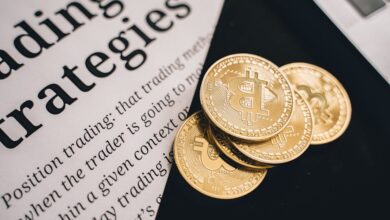Unlocking the Benefits of Gold ETFs: Your Guide to Investing in Physical Gold Safely and Smartly

In today's uncertain economic landscape, investors are increasingly turning to gold as a reliable safe haven asset. Among the various avenues available for gold investment, Gold Exchange-Traded Funds (ETFs) stand out for their unique structure and accessibility. Backed by physical gold, these financial instruments allow investors to easily gain exposure to the gold market without the complexities of storing and securing physical bullion. As we delve into the world of Gold ETFs, we will explore how they mirror gold prices and provide lucrative investment opportunities, while also assessing the impact of gold mining and recycling on their performance. From understanding the dynamics of gold market trends to evaluating sustainability in gold production, this article aims to equip you with the essential insights needed to navigate the evolving landscape of gold investments. Whether you're a seasoned investor or new to the gold trade, join us as we uncover the intricacies of Gold ETFs and their pivotal role in the global gold demand narrative.
- 1. **"Understanding Gold ETFs: The Safe Haven Asset Backed by Physical Gold"**
- 2. **"Navigating Gold Market Trends: How Gold ETFs Reflect Gold Prices and Investment Opportunities"**
- 3. **"The Impact of Gold Mining and Recycling on Gold ETFs: A Deep Dive into Gold Production and Sustainability"**
1. **"Understanding Gold ETFs: The Safe Haven Asset Backed by Physical Gold"**
Gold ETFs, or exchange-traded funds backed by physical gold, have emerged as a popular investment choice for those seeking a safe haven asset. These investment vehicles offer a unique opportunity to gain exposure to gold prices without the need to physically hold the metal. As investors navigate through fluctuating gold market trends, the appeal of gold ETFs continues to grow, particularly during times of economic uncertainty and inflation.
Understanding Gold ETFs begins with recognizing their structure. Each share of a gold ETF represents a specified amount of physical gold, typically stored in secure vaults. This backing by physical gold not only assures investors of the fund’s intrinsic value but also aligns with gold's historical role as a safe haven during economic downturns. Unlike traditional gold investments such as gold coins or jewelry, gold ETFs eliminate the challenges of storage, insurance, and liquidity, making them an attractive option for both seasoned investors and newcomers.
The gold market is influenced by various factors, including central banks' gold reserves, global gold demand, and advancements in gold technology. Furthermore, as the gold prices fluctuate, investors can take advantage of gold futures to hedge against market volatility. Gold ETFs provide a gateway to participate in the gold trade without the complexities associated with gold mining or gold refining processes.
Moreover, sustainable gold mining practices are gaining traction, reflecting a growing awareness of ethical investing. Investors are increasingly considering the implications of gold production on the environment, which has led to a rise in interest for responsibly sourced gold. This shift not only enhances the appeal of gold ETFs that prioritize sustainable practices but also aligns with the values of modern investors.
Additionally, gold recycling and the trade of luxury gold items, such as gold jewelry and collectibles, contribute to the overall dynamics of the gold market. With rising global gold demand, particularly in emerging markets, the importance of gold as a strategic investment choice is reaffirmed. As investors explore the intersection of gold and cryptocurrency, the stability that gold offers as a tangible asset remains unparalleled.
In summary, Gold ETFs represent an innovative and convenient way to invest in physical gold, allowing individuals to harness the benefits of this precious metal as a hedge against inflation and economic instability. With their backing of actual gold bullion, these ETFs serve not only as a gateway to gold investing but also as a reflection of larger trends in the gold market, including the impacts of gold smuggling, market analysis, and the evolving landscape of gold production and investment strategies.
2. **"Navigating Gold Market Trends: How Gold ETFs Reflect Gold Prices and Investment Opportunities"**
In today's dynamic financial landscape, understanding how gold ETFs respond to gold market trends is crucial for both seasoned investors and newcomers to gold investment. Gold ETFs, or exchange-traded funds backed by physical gold, provide a transparent and accessible way to invest in gold without the need to store physical gold bullion, coins, or jewelry. As safe haven assets, these funds often reflect fluctuations in gold prices, influenced by various factors, including economic stability, inflation, and central banks' gold reserves.
With ongoing global uncertainties, gold has consistently been viewed as a protective investment. For investors looking to navigate the complexities of gold market trends, gold ETFs serve as an effective tool. They mirror the performance of gold bullion and offer insights into market behaviors. For instance, during periods of high inflation, the demand for gold typically rises, driving up gold prices and, consequently, the value of gold ETFs. This relationship highlights the intrinsic link between gold and inflation, as gold is often perceived as a hedge against currency devaluation.
Moreover, gold ETFs provide opportunities to capitalize on gold mining trends and gold production levels. With sustainability becoming a priority, investors are increasingly interested in sustainable gold mining practices. These practices not only support responsible sourcing but also enhance the long-term viability of gold as an investment. As global gold demand continues to evolve, the impact of gold recycling and the emergence of luxury gold products further influence market dynamics.
Investors should also be aware of how gold futures trade alongside gold ETFs, as both can provide valuable insights into future gold prices. By analyzing gold market trends and conducting thorough gold market analysis, investors can make informed decisions about when to enter or exit their positions in gold ETFs. Additionally, the interplay between gold and cryptocurrency has emerged as a noteworthy trend, with some investors diversifying their portfolios by incorporating both assets.
Ultimately, gold ETFs represent a flexible investment vehicle that not only tracks the performance of physical gold but also reflects broader economic conditions and sentiments. By staying informed about gold market trends and understanding the factors influencing gold prices, investors can strategically position themselves to take advantage of potential opportunities within the ever-evolving gold landscape.
3. **"The Impact of Gold Mining and Recycling on Gold ETFs: A Deep Dive into Gold Production and Sustainability"**
Gold ETFs, or exchange-traded funds backed by physical gold, have gained significant traction among investors seeking a safe haven asset amid fluctuating market conditions. Understanding the dynamics of gold mining and recycling is crucial for evaluating the sustainability and long-term viability of these investment vehicles.
Gold production plays a pivotal role in the overall gold market trends, influencing gold prices and the availability of gold reserves. The mining process not only extracts valuable metals but also poses environmental challenges. Sustainable gold mining practices are increasingly being adopted to minimize the ecological footprint of gold extraction. This includes employing technologies that reduce water usage and energy consumption, as well as ensuring responsible labor practices. Investors are now more discerning, often favoring gold ETFs that align with ethical and sustainable mining practices.
In addition to mining, gold recycling is a vital component of the gold supply chain. Recycled gold, derived from old jewelry, industrial applications, and obsolete electronics, contributes significantly to the global gold demand. It not only helps to stabilize gold prices but also reduces the need for new mining operations, ultimately supporting sustainability in the gold market. The rise of gold recycling aligns well with current investment trends, as it promotes a circular economy and mitigates the environmental impact associated with traditional gold mining.
The interplay between gold mining, recycling, and the gold ETFs marketplace presents a unique opportunity for investors. As central banks continue to hold substantial gold reserves, the potential for gold prices to rise remains robust, especially in times of economic uncertainty and inflation. By investing in gold ETFs that are backed by both newly mined and recycled gold, investors can contribute to a more sustainable gold trade while still benefiting from the stability that gold offers.
In conclusion, as the gold market evolves, the integration of sustainable practices in both gold mining and recycling will be crucial for the future of gold investments. This shift not only enhances the appeal of gold ETFs but also positions them favorably within the broader context of luxury gold items, collectibles, and the emerging interest in gold and cryptocurrency. Understanding these factors is essential for anyone looking to navigate the intricate landscape of gold production and investment.
*(Image: Gold bars and coins representing investment options – Source: Website Name)*
In conclusion, gold ETFs present a compelling investment opportunity for those seeking a safe haven asset amid fluctuating economic conditions. As we’ve explored, these exchange-traded funds are not only backed by physical gold, but they also offer a unique way to navigate the complexities of gold market trends and prices. Investors can leverage gold ETFs to gain exposure to gold investments without the challenges associated with physical ownership, such as storage and security concerns.
The relationship between gold mining, recycling, and the overall sustainability of gold production is crucial in understanding the value of gold ETFs. With growing global demand for gold, the importance of sustainable practices in gold mining cannot be overstated. Investors should consider how these factors influence gold reserves and the broader gold trade, particularly in the context of gold prices and inflation.
As central banks continue to bolster their gold reserves and the interest in gold collectibles and cryptocurrency rises, the dynamics of the gold market remain ever-evolving. By keeping an eye on gold market analysis and recognizing the impact of gold production and refining, investors can make informed decisions about their gold investments.
Ultimately, whether you are interested in gold bars, gold bullion, or gold coins investing, gold ETFs offer a streamlined approach to accessing this timeless asset class. With the right knowledge and strategy, investors can effectively navigate the world of gold, ensuring they capitalize on its enduring value as a hedge against uncertainty and a potential growth opportunity in today’s financial landscape.
By understanding the multifaceted nature of gold and its role in the global economy, you can enhance your investment portfolio while embracing the potential of this luxury metal.
**References**
(Include a full list of sources cited in the article here, formatted in APA style.)





